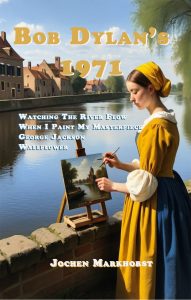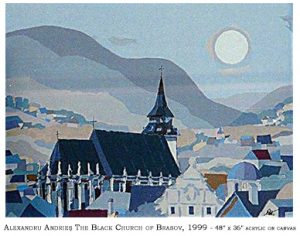 1971 is the fourth year of Dylan’s Seven Lean Years, the dry spell that Dylan himself places between John Wesley Harding (late 1967) and Blood On The Tracks (late 1974). These are the years when Dylan sits on the waterfront, watching the river flow, waiting for the inspiration to paint a masterpiece.
1971 is the fourth year of Dylan’s Seven Lean Years, the dry spell that Dylan himself places between John Wesley Harding (late 1967) and Blood On The Tracks (late 1974). These are the years when Dylan sits on the waterfront, watching the river flow, waiting for the inspiration to paint a masterpiece.
Then, in January ’71, a tape of Leon Russell floats by, inspiring a brief but long-legged revival: the songs Dylan recorded with Russell in March ’71 are on the setlist 50 years later, throughout the Rough & Rowdy Ways World Tour 2021-2024, night after night, some 200 times.
Apparently, they mean something to Dylan…
NL: Bob Dylans 1971 : Markhorst, Jochen: Amazon.nl: Boeken
UK: Bob Dylan’s 1971 (The Songs Of Bob Dylan): Amazon.co.uk: Markhorst, Jochen: 9798329337044: Books
US: Bob Dylan’s 1971 (The Songs Of Bob Dylan): Markhorst, Jochen: 9798329337044: Amazon.com: Books
DE: Bob Dylans 1971 (Die Songs von Bob Dylan) : Markhorst, Jochen: Amazon.de: Boeken
—————–
When I Paint My Masterpiece (1971) part 15 (final)
by Jochen Markhorst
XV An absolutely personal interpretation
 Located in southeastern Transylvania, in the centre of Romania at the foot of the Carpathian Mountains, Brașov has an eventful history. Over the centuries, it was a Saxon, Hungarian, Transylvanian and Austro-Hungarian town before gaining its current Romanian nationality in 1920. Its naming reflects the jumpy history: Brașov used to be called Corona, Kronstadt and Brasso, and when one of its most famous sons, Alexandru Andrieș, was born there in 1956, it was called Orașul Stalin – “Stalin City”.
Located in southeastern Transylvania, in the centre of Romania at the foot of the Carpathian Mountains, Brașov has an eventful history. Over the centuries, it was a Saxon, Hungarian, Transylvanian and Austro-Hungarian town before gaining its current Romanian nationality in 1920. Its naming reflects the jumpy history: Brașov used to be called Corona, Kronstadt and Brasso, and when one of its most famous sons, Alexandru Andrieș, was born there in 1956, it was called Orașul Stalin – “Stalin City”.
Andrieș is as multicoloured as his city’s history. Distinguished architect, graphic designer, celebrated poet, award-winning actor… but surely his main claim to fame is his music. His enormous body of work (“Awfully prolific. The collector’s nightmare,” according to his biographer Sergiu Mitrofan) includes more than 70 studio albums, live records, DVDs and more, he has performed thousands of times, probably more often even than his idol Dylan, and is still going strong.
His 1999 Dylan album Alb Negru (“White and Black”) is superb. Seventeen Dylan songs in Romanian, with lyrics he had already published separately in book form in 1991 on the occasion of Dylan’s 50th birthday (La mulți ani, Bob Dylan). For Dylan’s 60th birthday in 2001, another EP with Romanian versions of “It Ain’t Me, Babe”, “Shelter From The Storm” and “Motorpsycho Nightmare” – again very successful covers – was released as a bonus.
A highlight of Alb Negru is the intimate, casual performance of “You’re Gonna Make Me Lonesome When You Go” (Ma lasi prea singur dacă vei pleca), but the album’s closing track is certainly just as strong: Alexandru alone at the piano with his interpretation of “When I Paint My Masterpiece” – Cînd am să-mi pictez capodopera. In the album’s liner notes, Andrieș writes: “Acest album – o interpretare absolut personala, in cel mai poetic sens al cuvantului, a cantecelor lui Bob Dylan; This album – an absolutely personal interpretation, in the most poetic sense of the word, of the songs of Bob Dylan,” which is very well-put. Demonstrating this “absolutely personal” and “most poetic” with his translation of Masterpiece, for example.
The form is expertly maintained (rhyme scheme and almost identical metre), but with the melody, tempo and content of the lyrics Andrieș goes his own poetic way. This narrator also finds himself in a messy Rome, with “chunks of history” everywhere, but then takes his own, magically realistic turn: “S-a furat Coliseul, mai e doar un ciot – The Colosseum’s been stolen, there’s only a stump left…” Quickly back to the hotel, to call the police. At night, the narrator returns to the empty plain, sees a goddess wandering about, but “degeaba încerc să-i vorbesc, avem limbi diferite – no use trying to talk to her, we have different languages”. In the last stanza, in the taxi on the way to the airport, the fellow traveller asks what he thought of it, here in Rome. To that question, the narrator replies, you get your answer cînd am să-mi pictez capodopera – when I paint my masterpiece.
Magic realism like a Murakami story, a dreamlike interlude á la Petrushevskaya and a pinch of Kafka to conclude: for Alexandru, Dylan’s source text is a coat rack on which he hangs – very Dylanesque – the poetic fruits of his own associative mind. No pretty girl in the hotel room, no lions, Spanish Steps nor geese, munching journalists or muscle-sporting girls… so it is really not a translation of “When I Paint My Masterpiece” in the strict sense of the word. Alexandru Andrieș gives an absolutely personal interpretation, in the most poetic sense of the word.
Alexandru Andries – Cînd am sa-mi pictez capodopera:
Different but just as poetic is the third and final successful translation, made on the other side of the world by Japanese legend Haruomi Hosono. In Dylan circles, we have come across the electronica giant (Hosono is the driving force behind the revolutionary band Yellow Magic Orchestra in the 1970s) before; in 1969, he and his band Apryl Fool recorded a striking, peculiar cover of Dylan’s “Pledging My Time”. East meets West doesn’t really work for that cover yet, but in 2013 we are 44 years older and correspondingly much craftsmanship richer.
On Heavenly Music, Hosono honours his musical heroes, the American songs he learned to appreciate during the American occupation and helped him through the misery of post-war Tokyo (Hosono was born in 1947). Influences we have been able to hear throughout his oeuvre, but on this album it is thematised. With an exquisite Japanese touch: stillness and introspection. As in his cover of Burt Bacharach’s “Close To You”, which begins like a soft rain shower in May, with thin chords on the piano steadily trickling down, dull beating on the roof by the drums and a bass half-mixed away – as if you’re faintly hearing the neighbour’s radio. “Tip Toe Thru The Tulips With Me” Hosono sings in Japanese, accompanied by an accordion that takes us to Place Pigalle, “Something Stupid” is a faithful copy of Nancy Sinatra & Lee Hazlewood’s classic, “My Bank Account Is Gone” by Jesse Ashlock from Hosono’s birth year 1947 sounds oddly even more authentic than the original… Heavenly Music surprises the listener with one gem after another.
The biggest surprise is the closing track. Hosono’s covers a monument from his German art brothers from Düsseldorf, the electronics concern Kraftwerk. Not only surprising because Hosono precisely chooses “Radio Activity” of all things, thus giving a place to the horrors of post-war Japan, but also because of the exceptional arrangement: the synthesiser classic is now carried by acoustic guitar and piano, the electronics relegated to atmospheric noise in the background á la Radiohead. In the short interlude halfway through, early 70s Brian Eno violence unleashes itself very briefly, but then the radio-active cloud descends, and hushed the album ends.
Shortly before that, at track 8, is Hosono’s tribute to Dylan: “When I Paint My Masterpiece”. Similar both in sound and instrumentation to Dylan’s Shadow Kingdom version (and thus also to The Band); accordion, upright bass, mandolin and acoustic guitar. But, like only the greatest artists, Hosono goes his own way with the lyrics – and survives. More than satisfactory, even.
Hosono’s “translation” is similar to Romanian Andrieș in approach: the source text is merely a coat rack. The elaboration, however, is diametrically opposite. Whereas Andrieș still extrapolates the fantasy elements and lifts the content of the text towards surrealism, Hosono opts for naturalism, for sobriety. Hosono’s narrator walks through Rome and is cold, quickly returns to his hotel room. No Botticelli, no Venus – here is the Greek girl again, and she is kawaii, cute. At the Colosseum, he wastes his time in mui, “idleness”, and Hosono eliminates something as unrealistic as lions supposedly roaming there. No, he only notices a shishi no zou, a statue of a lion. “Geese” for that matter also seem too exotic for unclear reasons – here the narrator recalls a hunt for ducks. Understandable, on the other hand, is how a Japanese might find clergymen in uniform too alienating, so that becomes – very Japanese – sou, monks. And thus, Hosono is also the only one in the world who finds young girls pulling muscles far too weird and unrealistic, and therefore makes grateful use of the homophones muscles/mussels: the young girls in Brussels open kai – “shellfish”.
Haruomi Hosono – When I Paint My Masterpiece:
Many translations, all in all, but only three of them doing what a cover should do: enrich the original. With which Dylan himself, despite that strange condition in the licence agreement with the German translators Carl Weissner and Walter Hartmann, surely would agree. And if he then had to choose between German Wolfgang Niedecken, Romanian Alexandru Andrieș and Japanese Haruomi Hosono, his heart would presumably incline towards the Japanese. Haruomi is the grandson of Masabumi Hosono, the only Japanese passenger and survivor of the Titanic – and well, then you do have an edge with Dylan. Plus: nobody sighs “Coca-Cola” as nostalgically, as full of lost akogare, longing as Haruomi.
When I Paint My Masterpiece part 14: Un appuntamento con la nipote di Botticelli
Jochen is a regular reviewer of Dylan’s work on Untold. His books, in English, Dutch and German, are available via Amazon both in paperback and on Kindle:
- Blood on the Tracks: Dylan’s Masterpiece in Blue
- Blonde On Blonde: Bob Dylan’s mercurial masterpiece
- Where Are You Tonight? Bob Dylan’s hushed-up classic from 1978
- Desolation Row: Bob Dylan’s poetic letter from 1965
- Basement Tapes: Bob Dylan’s Summer of 1967
- Mississippi: Bob Dylan’s midlife masterpiece
- Bob Dylan’s Greatest Hits
- John Wesley Harding: Bob Dylan meets Kafka in Nashville
- Tombstone Blues b/w Jet Pilot: Dylan’s lookin’ for the fuse
- Street-Legal: Bob Dylan’s unpolished gem from 1978
- Bringing It All Back Home: Bob Dylan’s 2nd Big Bang
- Time Out Of Mind: The Rising of an Old Master
- Crossing The Rubicon: Dylan’s latter-day classic
- Nashville Skyline: Bob Dylan’s other type of music
- Nick Drake’s River Man: A very British Masterpiece
- I Contain Multitudes: Bob Dylan’s Account of the Long Strange Trip
- Bob Dylan’s Rough And Rowdy Ways – Side B
- Bob Dylan’s High Water (for Charley Patton)
